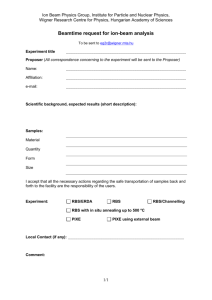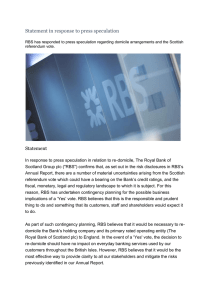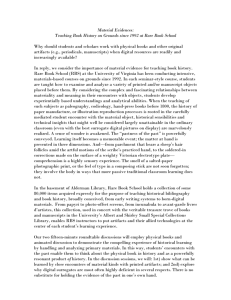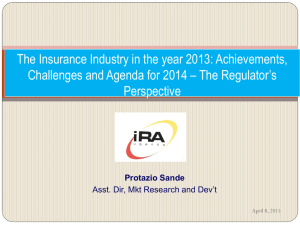Document 10834449
advertisement
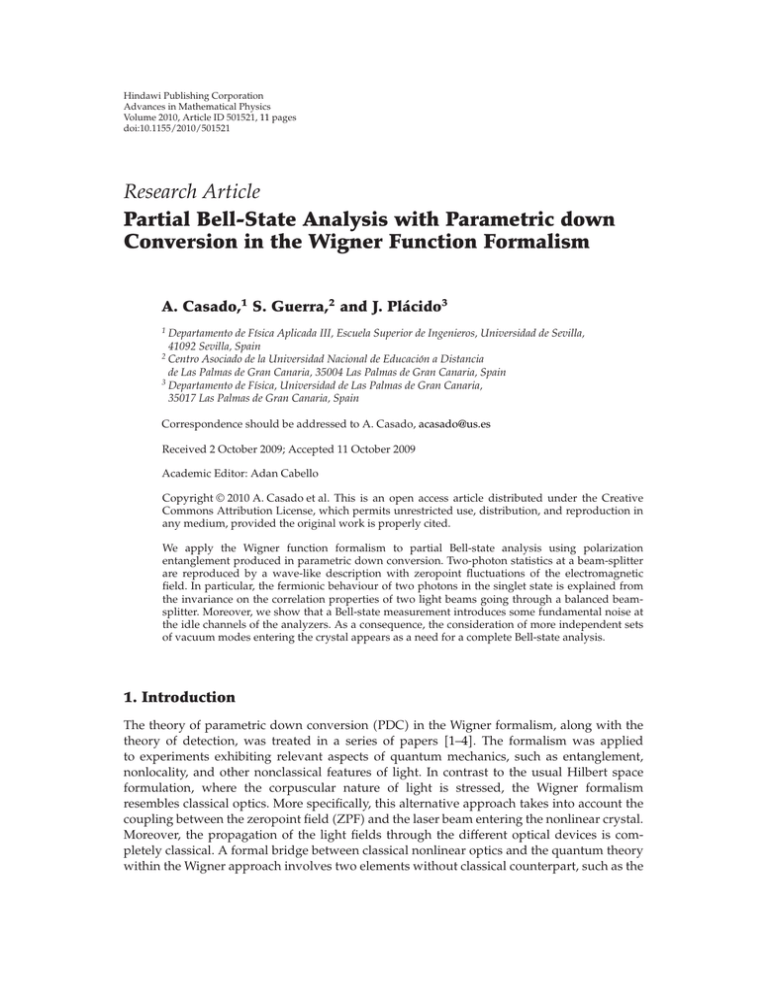
Hindawi Publishing Corporation
Advances in Mathematical Physics
Volume 2010, Article ID 501521, 11 pages
doi:10.1155/2010/501521
Research Article
Partial Bell-State Analysis with Parametric down
Conversion in the Wigner Function Formalism
A. Casado,1 S. Guerra,2 and J. Plácido3
1
Departamento de Fı́sica Aplicada III, Escuela Superior de Ingenieros, Universidad de Sevilla,
41092 Sevilla, Spain
2
Centro Asociado de la Universidad Nacional de Educación a Distancia
de Las Palmas de Gran Canaria, 35004 Las Palmas de Gran Canaria, Spain
3
Departamento de Fı́sica, Universidad de Las Palmas de Gran Canaria,
35017 Las Palmas de Gran Canaria, Spain
Correspondence should be addressed to A. Casado, acasado@us.es
Received 2 October 2009; Accepted 11 October 2009
Academic Editor: Adan Cabello
Copyright q 2010 A. Casado et al. This is an open access article distributed under the Creative
Commons Attribution License, which permits unrestricted use, distribution, and reproduction in
any medium, provided the original work is properly cited.
We apply the Wigner function formalism to partial Bell-state analysis using polarization
entanglement produced in parametric down conversion. Two-photon statistics at a beam-splitter
are reproduced by a wave-like description with zeropoint fluctuations of the electromagnetic
field. In particular, the fermionic behaviour of two photons in the singlet state is explained from
the invariance on the correlation properties of two light beams going through a balanced beamsplitter. Moreover, we show that a Bell-state measurement introduces some fundamental noise at
the idle channels of the analyzers. As a consequence, the consideration of more independent sets
of vacuum modes entering the crystal appears as a need for a complete Bell-state analysis.
1. Introduction
The theory of parametric down conversion PDC in the Wigner formalism, along with the
theory of detection, was treated in a series of papers 1–4. The formalism was applied
to experiments exhibiting relevant aspects of quantum mechanics, such as entanglement,
nonlocality, and other nonclassical features of light. In contrast to the usual Hilbert space
formulation, where the corpuscular nature of light is stressed, the Wigner formalism
resembles classical optics. More specifically, this alternative approach takes into account the
coupling between the zeropoint field ZPF and the laser beam entering the nonlinear crystal.
Moreover, the propagation of the light fields through the different optical devices is completely classical. A formal bridge between classical nonlinear optics and the quantum theory
within the Wigner approach involves two elements without classical counterpart, such as the
2
Advances in Mathematical Physics
ZPF itself, entering into the crystal and the rest of optical devices, and the detection process, in
which those vacuum fluctuations are substracted, giving rise to the typically quantum results.
The development of quantum information in the recent years, alongside with the
important role of parametric down conversion for experimental schemes, has motivated the
application of the Wigner approach to some relevant contexts, up to now almost exclusively
linked to the Hilbert domain. Examples of these are quantum cryptography 5, dense coding
6, and teleportation 7, 8. This research program seeks to apply an alternative explanation
for that kind of phenomena, an explanation nevertheless consistent with quantum theory,
and therefore with the usual Hilbert space formulation.
Recently, the Wigner formalism has been applied to experiments on quantum
cryptography based on the Ekert’s protocol 9, also including the presence of eavesdropping
in the case of projective measurements. There, it was shown that the Heisenberg uncertainty
principle, a key aspect in secure quantum cryptography, is related to the change of the
correlation properties of light fields, after going through the optical devices in Alice’s and
Bob’s setups. These correlation properties are affected by vacuum modes activated in the
crystal, which give rise to quantum entanglement. Furthermore, the action of Eve introduces
some noise, that also turns out to be fundamental to reproduce the quantum results 10.
Bell-state measurements constitute another key aspect in the field of quantum
information, posing a relevant problem in quantum dense coding and teleportation schemes.
In this context, entangled photon pairs produced in parametric down conversion have also
been used in the last decades for experiments on partial Bell-state measurement 11, in which
entanglement involves only one degree of freedom, and complete Bell-state measurement, in
which hyperentanglement entanglement between two or more degrees of freedom takes
part 12.
The paper is organized as follows. In Section 2, we introduce the general description of
the four Bell-states within the Wigner framework. This description involves the manipulation
of only one beam. In this same section, we also study two-photon statistics at a balanced
beam-splitter. In Section 3 we study an experiment on partial Bell-state analysis 11. Finally,
in Section 4, we discuss the results, making a comparison with the Hilbert space description.
2. Two-Photon Statistics at a Beam-Splitter in the Wigner Approach
We will start this section by reviewing the basic concepts in the Hilbert framework 13. The
four Bell-states entangled in polarization produced in the process of PDC are
±
Ψ √1 |H |V ± |V |H ,
1
2
1
2
2
±
Φ √1 |H |H ± |V |V ,
1
2
1
2
2
2.1
where HV represents linear horizontal vertical polarization. Let us suppose that the two
beams are recombined at a balanced beam splitter BS. If |a and |b represent the input
modes of the BS, the possible spatial states are
ψA √1 |a |b − |b |a ,
1
2
1
2
2
ψS √1 |a |b |b |a ,
1
2
1
2
2
2.2
Advances in Mathematical Physics
3
where AS denotes antisymmetric symmetric. Due to the fact that the particles carrying
the information are photons, the total state must obey the bosonic symmetry, so that the total
two photon states are |Ψ
|ψS , |Ψ− |ψA , |Φ
|ψS , |Φ− |ψS . Assuming that the BS does not
influence the internal state polarization, the two-photon state can only be changed in the
√
spatial part, via the Hadamard transformation, as H|a
1/ 2|a |b and H|b
√
A |ψA , only in this case the two photons emerge at the
1/ 2|a − |b. Owing to H|ψ
different outputs from the BS. In the other three cases, the two photons emerge together in
one of the two outputs ports 14.
Let us now go to the Wigner formalism. The Wigner transformation stablishes a
correspondence between a field operator acting on a vector in the Hilbert space and a
complex amplitude of the field. In the case of zeropoint field, these amplitudes follow a
particular stochastic distribution, given by the Wigner function of the vacuum.
Quantum predictions corresponding to the state |Ψ
are reproduced in the Wigner
framework by considering the following two correlated beams outgoing the crystal 2:
F1 r, t Fs
F2 r, t Fq
r, t; αk1 ,H ; α∗k2 ,V i Fp r, t; αk1 ,V ; α∗k2 ,H j,
r, t; αk2 ,H ; α∗k1 ,V i Fr r, t; αk2 ,V ; α∗k1 ,H j ,
2.3
where i and i j and j are unit vectors representing horizontal vertical linear polarization
−
−
; α→
} i 1, 2 represent four sets of relevant zeropoint
at beams “1” and “2” and {α→
k i ,V
k i ,H
→
−
amplitudes entering the crystal. The four set of modes { k i,λ } i 1, 2; λ ≡ H, V are
“activated” and coupled with the laser beam inside the nonlinear medium.
− } follow a distribution given by the Wigner function
As said before, amplitudes {α→
k ,λ
of the vacuum field 1:
WZPF {α} 2
π
k,λ
2
e−2|αk,λ | .
2.4
If Ar, t; {α} and Br , t ; {α} are two complex amplitudes, the correlation between them is
given by:
AB WZPF {α}Ar, t; {α}B r , t ; {α} d{α}.
2.5
In expressions 2.3, the only nonvanishing correlations are those involving the
combinations r ↔ s and p ↔ q. These correlations are directly related to the way in which the
vacuum components are distributed inside the total field amplitudes.
The four Bell-states can be generated by manipulating only one beam, and this is
related to the possibility of sending two bits of classical information via the manipulation
of only one particle 6. In the Wigner framework, the effect of a linear optical device on
a beam accounts for a change on the distribution of zeropoint amplitudes inside the field
components. Therefore, correlation properties are also changed. In 10 we performed the
same analysis on the four Bell-states, this time considering a modification of the two beams,
initially departing from the description of |Ψ
. In this paper, in order to keep consistency
4
Advances in Mathematical Physics
with the essence of dense coding, we will consider that the optical devices modify only one
of the beams, while the other beam remains unchanged from its generation at Bob’s station.
Let us now focus on the experimental setup in Figure 1. The transformations at Bob’s
station are performed by a polarization rotator and a wave retarder. For instance, if we place
a polarization rotator acting on beam “1”, the plane of polarization of F1 will be rotated by
an angle β. We can compute the field components behind the rotator in the following way:
F 1 r, t
⎞
⎛ Fs r, t
⎠
⎝
cos β
Fp r, t
cos β − sin β
sin β
⎛
⎝
Fs r, t cos β
Fp r, t sin β
−
Fs r, t sin β
Fp r, t cos β
2.6
⎞
⎠.
Now, let the wave retarder introduce a phase shift κ between the horizontal and
vertical field components of beam “1”. Taking into account the action of both optical devices,
the expressions of the beams are
F1
r, t Fs r, t cos β − Fp r, t sin β i
eiκ Fs r, t sin β Fp r, t cos β j,
2.7
F2 Fq r, ti Fr r, tj .
The combination β 0, κ 0 gives 2.3, corresponding to the state |Ψ
. On the other
hand, for β 0 and κ π we obtain the description of |Ψ− :
F1 r, t Fs r, ti − Fp r, tj,
F2 r, t Fq r, ti Fr r, tj .
2.8
In both cases the horizontal component of one beam is correlated with the vertical component
of the other, the only difference being the minus sign that appears in F1 in the case of |Ψ− .
Finally, the case β −π/2 and κ π corresponds to the description of |Φ
F1 r, t Fp r, ti Fs r, tj,
2.9
2.10
F2 r, t Fq r, ti Fr r, tj ,
and β −π/2, κ 0 corresponds to the description of |Φ− :
F1 r, t Fp r, ti − Fs r, tj,
F2 r, t Fq r, ti Fr r, tj .
Advances in Mathematical Physics
5
In these two cases we observe that the horizontal vertical component of one beam is
correlated with the horizontal vertical component of the other, the difference being the
minus sign that appears in F1 in the case of |Φ− .
This description of the four Bell-states is equivalent to the one in 10. Nevertheless,
as we already pointed out, in this case we have modified only one of the two beams. The net
effect of the polarization rotator and the wave retarder is similar to the one of a half-wave
plate and a quarter-wave plate, used in 11.
The general expressions 2.7, where the values of β and κ are undetermined, correspond, in the Hilbert space, to a superposition of the base states |Ψ
, |Ψ− , |Φ
, and |Φ− .
We will now study the action of a balanced beam-splitter on the correlation properties
of the light beams. For the sake of clarity, we suppose an identical distance separating the
source from the BS’s, so the contribution of the phase shift in 2, equation 16 can be
ignored.
Because there is one beam at each input port, it is not necessary to consider the vacuum
field at the beam-splitter 15. This time the BS does not introduce any additional noise to the
one provided by the zeropoint field entering the crystal. The beams are represented by 2.7,
r rBS , with rBS being the position of the beam-splitter where the two beams are recombined.
For the light beams at the outgoing channels we have
F1,out rBS , t F1H rBS , ti F1V rBS , tj,
2.11
F2,out rBS , t
F2H rBS , ti
F2V rBS , tj ,
where
1 F1H rBS , t √ iFq rBS , t Fs rBS , t cos β − Fp rBS , t sin β ,
2
2.12
1 F1V rBS , t √ iFr rBS , t eiκ Fs rBS , t sin β Fp rBS , t cos β ,
2
2.13
1 F2H rBS , t √ Fq rBS , t iFs rBS , t cos β − iFp rBS , t sin β ,
2
2.14
1 F2V rBS , t √ Fr rBS , t ieiκ Fs rBS , t sin β Fp rBS , t cos β .
2
2.15
We now calculate the cross-correlations between the components of F1,out rBS , t and
those of F2,out rBS , t.
1 The correlation between the field components corresponding to the same
polarization at the outgoing channels vanishes, independently of the values of κ and β. This
6
Advances in Mathematical Physics
is due to the fact that the contribution to the correlation of the transmitted components of the
field is cancelled by the contribution of the reflected components:
1
F1H rBS , tF2H rBS , t − sin β Fp rBS , tFq rBS , t 1 i2 0,
2
1
F1V rBS , tF2V rBS , t eiκ sin β Fr rBS , tFs rBS , t 1 i2 0.
2
2.16
2.17
2 For the correlation between the field components corresponding to different polar
ization and different outgoing channels, F2H rBS , tF1V rBS , t and F2V rBS , tF1H rBS , t,
we have
F1H rBS , tF2V rBS , t − F1V rBS , tF2H rBS , t
cos β Fs rBS , tFr rBS , t i2 eiκ Fq rBS , tFp rBS , t .
2
2.18
As there is no path difference before the beam-splitter between F1,out and F2,out , the cross
correlations Fs r, tFr r , t and Fq r , t Fp r, t, computed at the same position rBS
and time t, have the same value. With all this, we have
F1H rBS , tF2V rBS , t − F1V rBS , tF2H rBS , t
cos β Fs rBS , tFr rBS , t 1 i2 eiκ .
2
2.19
We can see that if β π/2, that is, the states |Φ± , the latter correlations vanish. On the other
hand, in the case of |Ψ
κ 0 and β 0 these correlations are also null. Finally, only when
β 0 and κ π, that is, the state |Ψ− , these correlations are different from zero:
F1H rBS , tF2V rBS , t − F1V rBS , tF2H rBS , t
Fs rBS , tFr rBS , t
2.20
.
3 To conclude, we compute the correlations between the two field components of
different polarization, corresponding to the same outgoing beam,
F1H rBS , tF1V rBS , t F2H rBS , tF2V rBS , t
i cos β Fs rBS , tFr rBS , t eiκ Fq rBS , tFp rBS , t
2
i cos β Fs rBS , tFr rBS , t 1 eiκ .
2
2.21
Advances in Mathematical Physics
7
→
−
α2,V j →
−
α2,H i
Alice
DH2
−−→
K2
PBS2
Beam 1
Polarization
rotator
Nonlinear
crystal
Laser beam
Bob
Zero point field
Wave
retarder
DH1
BS
→
−
α1,V j
PBS1
DV1
Zero point field
→
−
α1,H i
DV2
−−→
K1
Zero point field
Beam 2
Figure 1: Setup for quantum dense coding. The polarization rotator and the wave retarder used by Bob
allow a transmission to Alice of any of the Bell-states. Alice’s station consists on a balanced beam-splitter,
two polaryzing beam-splitters, and detectors DH1, DV1, DH2, and DV2.
It can be easily seen that the correlations above are different from zero only for the state |Ψ
κ 0 and β 0. In this situation, we have
F1H rBS , tF1V rBS , t F2H rBS , tF2V rBS , t
i
Fs rBS , tFr rBS , t
2.22
.
3. Partial Bell-State Analysis in the Wigner Approach
Let us again consider the situation in Figure 1. The nonlinear medium is an element of
a quantum-optical experimental scheme for dense coding 11. The two beams 2.3 are
correlated through the zeropoint field entering the crystal, which is “amplified” via the
→
−
activation of the four set of vacuum modes { k i,λ } i 1, 2; λ ≡ H, V . The beam “1” can be
modified at Bob’s station, who can activate the polarization rotator and/or the wave retarder.
Manipulation of beam “1” allows for the possibility of distributing the vacuum amplitudes in
four different ways, so that the correlation properties of beams “1” and “2” can be modified
and used for information encoding. In our framework, the possibility of sending two bits of
classical information via the manipulation of one particle is explained through the change
on the correlation properties of two beams when one of them is modified at Bob’s station.
Such correlations have their origin in the crystal, where the zeropoint modes are coupled
with the laser field, and the information is carried by the amplified vacuum fluctuations
16, 17.
The two beams are recombined at Alice’s Bell-state analyser by means of a balanced
beam-splitter BS, and the horizontal and vertical polarization components of each outgoing
beams are separated at the polarizing beam-splitters PBS1 and PBS2. Finally, all coincidence
detection probabilities can be measured with the detectors DH1, DH2, DV1, and DV2.
8
Advances in Mathematical Physics
We focus now on the fields at the detectors. We will suppose that there is the same
distance between the BS and any of the detectors, and again the phase factor corresponding
to the propagation of the different amplitudes is irrelevant. Owing to the fact that each
polaryzing beam-splitter reflects transmits the horizontal vertical polarization, the electric
field at the detector DH1, DV1, DH2, DV2 is the superposition of iF1H , F1V , iF2H , F2V and a vacuum field amplitude which has been reflected, transmitted, reflected, transmitted
at the other idle channel of the corresponding PBS. These vacuum amplitudes have no
correlation with the signals, nor they have with each other. If FZPF,Alice1 FZPF,Alice2 is the
vacuum field entering PBS1 PBS2, for the field amplitudes at the detectors we have
FDH1 rDH1 , t1 iF1H rDH1 , t1 i FZPF,Alice1 rDH1 , t1 · j j,
FDV1 rDV1 , t1 F1V rDV1 , t1 j i FZPF,Alice1 rDV1 , t1 · i i,
FDH2 rDH2 , t2 iF2H rDH2 , t2 i FZPF,Alice2 rDH2 , t2 · j j ,
3.1
FDV2 rDV2 , t2 F2V rDV2 , t2 j i FZPF,Alice2 rDV2 , t2 · i i ,
where F1H , F1V , F2H , F2V are given by 2.12, 2.13, 2.14, and 2.15, respectively, owing to
the path length from the BS to each detector is the same, so that the related phase shifts in 2,
equation 16 can be discarded.
To calculate joint detection probabilities we use see 2, equation 28
2
PAB r, t; r , t ∝
Fλ φA ; r, t Fλ φB ; r , t ,
λ
3.2
λ
where λ and λ are polarization indices, and φA and φB represent controllable parameters of
the experimental setup.
For instance, let us show the calculation of PDH1,DH2 . For simplicity we focus on the
ideal situation with t1 t2 , and discard the dependence on position and time. We have
2
2 PDH1,DH2 ∝ F1H F2H F1H FZPF,Alice2 · j 2 2
2
FZPF,Alice1 · j F2H FZPF,Alice1 · j FZPF,Alice2 · j F1H F2H ,
3.3
Advances in Mathematical Physics
9
where we have taken into account that the ZPF inputs at the PBS’s are uncorrelated with the
signals and with each other. With 2.16, we finally obtain
PDH1,DH2 0.
3.4
The rest of the probabilities can be obtained similarly. By using 2.17, 2.19, and
2.21, we find
PDV1,DV2 0,
PDH1,DV2 PDV1,DH2 cos2 β
2
1 cosκ π Fs Fr ,
kDH1,DV2 kDV1,DH2
2
3.5
PDH1,DV1 PDH2,DV2 cos2 β
2
1 cos κ Fs Fr ,
kDH1,DV1 kDH2,DV2
2
where kDH1,DV2 , kDV1,DH2 , kDH1,DV1 , and kDH2,DV2 are constants related to the effective
efficiency of the detection processes.
From 3.4 and 3.5 we conclude that
i recording a coincidence of DH1 and DH2 DV1 and DV2 is not possible, for
whatever κ and β,
ii recording a coincidence of DH1 and DV2 DV1 and DH2 is possible only in the
case β 0, κ π, that is, the state |Ψ− ,
iii recording a coincidence of DH1 and DV1 DH2 and DV2 is possible only for β 0, κ 0, that is, the state |Ψ
,
iv when β π/2, that is, the states |Φ± , all coincidence probabilities vanish. Hence,
these Bell-states cannot be distinguished.
4. Discussion
We have applied the Wigner approach to study two-photon statistics at a balanced beam
splitter. We have also treated an experimental setup for partial Bell-state analysis. The Wigner
formalism allows for an interpretation of these experiments in terms of waves, but, however,
the whole formalism lies inside the quantum domain, the zeropoint field being an alternative
to the role of vacuum fluctuations in the Hilbert space.
As we already pointed out, once in the Wigner framework, the typical quantum results
appear precisely as a consequence of the introduction of the zeropoint field. This vacuum
field enters in the crystal and also in the rest of optical devices. Finally, it is substracted
in the detection process. Quantum correlations can be then explained solely in terms of
the propagation of those vacuum amplitudes through the experimental setup, and their
subsequent substraction at the detectors.
At the beginning of Section 2 we presented the fundamental ideas on two-photon
statistics at a beam-splitter in the Hilbert space formalism, which account for the usual
corpuscular description of light. In the Wigner framework, a clear counterpart to that
description is found when, in order to preserve the bosonic character of the photons, the
spatial part of the quantum state is forced to remain antisymmetric. This happens only for
10
Advances in Mathematical Physics
|Ψ− , and, in this case, the pair of photons behaves as fermions at the beam-splitter, emerging
at different output ports. For the other three Bell-states, in which both the polarization and
spatial parts of the two-photon state are symmetric, both particles emerge together at the
same output port of the BS.
For the Wigner representation, the corpuscular aspect of light appears as just an
interplay of Maxwell waves, including a zeropoint vacuum field. The action of the
beam-splitter must be treated as in the classical framework: a part of each entering beam
is transmitted, and the other part is reflected, without any change in their polarization
properties. From 2.19, it can be seen that the correlation between the field components
corresponding to different polarization and different outgoing channels vanishes for β π/2
states |Φ± , and also for κ 0 state |Ψ
. In this last case, the factor i2 indicates that the
contribution to the correlation of the transmitted components is cancelled by the contribution
of the reflected components. Nevertheless, in the case of |Ψ− there is a constructive
superposition of the two terms in 2.19. In other words, the net effect of the phase shift
κ π and the beam-splitter in the field amplitudes is to leave correlations unchanged. This
is equivalent, in the Hilbert space, to the fact that |ψA see 2.2 is an eigenstate of the
Hadamard operator.
At this point it is worth to stop again at the question: how can we explain a typical
particle behaviour the bosonic nature of photons in the Hilbert space description, from a
wave-like description, just with the inclusion of vacumm fluctuations of the electromagnetic
field? By inspection of 2.7, it can easily be seen that, only in the case of |Ψ− , the exchange
1 ↔ 2 implies a sign flip in the correlation properties of the beams they remain equal in the
other three cases. The bosonic nature of photons is completely represented by the correlation
properties that characterize each of the four Bell-states. If now Bob activates just the wave
retarder, this gives rise to a change, not only in the internal polarization state, but also in
the spatial part of the quantum state, in order to keep the requirement of boson symmetry.
This “double” effect is explained in the Wigner formalism by taking into account the way in
which the zeropoint field is coupled inside the crystal 2.
The Bell-state measurement performed at Alice’s station only identifies the states |Ψ− and |Ψ
. We complete our picture here by pointing out that the analyzer introduces some
fundamental noise at the idle channels of the polaryzing beam splitters. These zeropoint
fluctuations, although they will again be finally substracted at the detectors, and again
hold no correlation with the signals, turn out to be the fundamental ingredient of the Wigner
approach to this experimental setups. A quick look at Figure 1 shows that there are four
relevant sets of vacuum modes entering the crystal, in which the quantum information
is “carried,” and another two sets of vacuum modes entering the PBS’s, containing only
zeropoint field. This image constrasts to the usual “qubit language,” where “particles carry
the information” 13.
Recently, the problem of performing complete Bell-state measurements has been
solved by considering a higher number of degrees of freedom hyperentanglement.
Hyperentanglement is also a convenient resource for some other recent and important
applications in the field of quantum computing. An example of these is one-way quantum
computation using clusters states 18. The use of Hilbert spaces of higher dimension is
related, within the Wigner formalism, to the inclusion of more sets of vacuum modes entering
the crystal. With increasing number of vacumm inputs, the possibility for extracting more
information from the zeropoint field also increases. For instante, the momentum-polarization
hyperentanglement needs, in the Wigner framework, the consideration of 8 sets of relevant
modes of the zeropoint field entering the crystal 19.
Advances in Mathematical Physics
11
Acknowledgments
The authors thank Professor E. Santos for helpful suggestions and comments on the work.
They also thank R. Risco and D. Rodrı́guez for their comments and careful reading of the
manuscript. A. Casado acknowledge the support from the Spanish MCI Project no. FIS200805596.
References
1 A. Casado, A. Fernández-Rueda, T. Marshall, R. Risco-Delgado, and E. Santos, “Fourth-order
interference in the Wigner representation for parametric down-conversion experiments,” Physical
Review A, vol. 55, no. 5, pp. 3879–3890, 1997.
2 A. Casado, T. W. Marshall, and E. Santos, “Type II parametric downconversion in the Wigner-function
formalism: entanglement and Bell’s inequalities,” Journal of the Optical Society of America B, vol. 15, no.
5, pp. 1572–1577, 1998.
3 A. Casado, A. Fernández-Rueda, T. Marshall, J. Martı́nez, R. Risco-Delgado, and E. Santos,
“Dependence on crystal parameters of the correlation time between signal and idler beams in
parametric down conversion calculated in the Wigner representation,” European Physical Journal D,
vol. 11, no. 3, pp. 465–472, 2000.
4 A. Casado, T. Marshall, R. Risco-Delgado, and E. Santos, “Spectrum of the parametric down converted
radiation calculated in the Wigner function formalism,” European Physical Journal D, vol. 13, no. 1, pp.
109–119, 2001.
5 N. Gisin, G. Ribordy, W. Tittel, and H. Zbinden, “Quantum cryptography,” Reviews of Modern Physics,
vol. 74, no. 1, pp. 145–195, 2002.
6 C. H. Bennett and S. J. Wiesner, “Communication via one- and two-particle operators on EinsteinPodolsky-Rosen states,” Physical Review Letters, vol. 69, no. 20, pp. 2881–2884, 1992.
7 D. Bouwmeester, J.-W. Pan, K. Mattle, M. Eibl, H. Weinfurter, and A. Zeilinger, “Experimental
quantum teleportation,” Nature, vol. 390, no. 6660, pp. 575–579, 1997.
8 D. Boschi, S. Branca, F. De Martini, L. Hardy, and S. Popescu, “Experimental realization of teleporting
an unknown pure quantum state via dual classical and einstein-podolsky-rosen channels,” Physical
Review Letters, vol. 80, no. 6, pp. 1121–1125, 1998.
9 A. K. Ekert, “Quantum cryptography based on Bell’s theorem,” Physical Review Letters, vol. 67, no. 6,
pp. 661–663, 1991.
10 A. Casado, S. Guerra, and J. Plácido, “Wigner representation for experiments on quantum cryptography using two-photon polarization entanglement produced in parametric down-conversion,” Journal
of Physics B, vol. 41, no. 4, Article ID 045501, 2008.
11 K. Mattle, H. Weinfurter, P. G. Kwiat, and A. Zeilinger, “Dense coding in experimental quantum
communication,” Physical Review Letters, vol. 76, no. 25, pp. 4656–4659, 1996.
12 P. G. Kwiat and H. Weinfurter, “Embedded Bell-state analysis,” Physical Review A, vol. 58, no. 4, pp.
R2623–R2630, 1998.
13 D. Bouwmeester, A. Ekert, and A. Zeilinger, The Physics of Quantum Information, Springer, Berlin,
Germany, 2000.
14 R. Loudon, “Fermion and boson beam-splitter statistics,” Physical Review A, vol. 58, no. 6, pp. 4904–
4909, 1998.
15 L. Mandel and E. Wolf, Optical Coherence and Quantum Optics, Cambridge University Press,
Cambridge, UK, 1995.
16 W. H. Louisell, A. Yariv, and A. E. Siegman, “Quantum fluctuations and noise in parametric processes:
I,” Physical Review, vol. 124, no. 6, pp. 1646–1654, 1961.
17 J. P. Gordon, W. H. Louisell, and L. R. Walker, “Quantum fluctuations and noise in parametric
processes: II,” Physical Review, vol. 129, no. 1, pp. 481–485, 1963.
18 G. Vallone, E. Pomarico, P. Mataloni, F. De Martini, and V. Berardi, “Realization and characterization
of a two-photon four-qubit linear cluster state,” Physical Review Letters, vol. 98, no. 18, Article ID
180502, 2007.
19 A. Casado, S. Guerra, and J. Plácido, “Análisis de estados hiperentrelazados con el formalismo de
la fun-ción de wigner en el marco de heisenberg,” in Proceedings of the 32nd Reunión Bienal de la Real
Sociedad Española de Fı́sica, pp. 519–520, Ciudad Real, Spain, 2009.
